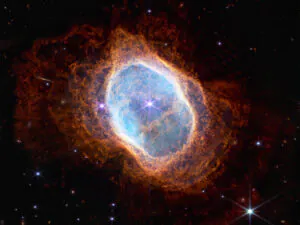NASA Releases First Images From The James Webb Space Telescope

Over seven months after it launched into space, completed its deployment and reached its orbital position, NASA has finally unveiled the first batch of images taken by the James Webb Space Telescope (JWST). The awe-inspiring images were released one-by-one last night during a live stream event by the agency, where experts gave detailed explanations of each picture.
Webb’s First Deep Field

First off, the entire world got an early preview on Monday when US President Joe Biden revealed the first image, known as Webb’s First Deep Field, the sharpest deep field image to date which includes galaxies believed to have existed since the universe was less than a billion years old. The picture was of the galaxy cluster SMACS 0723, which had previously been captured by the Hubble Space Telescope in 1995.
Hubble took over 10 days with over 100 hours of exposure to get the snapshot, with a higher resolution image released in 2012 that collectively took 50 days worth of observations. In comparison, JWST only took 12.5 hours to capture a portion of the universe that NASA says is equivalent to looking at a grain of sand at arm’s length.
WASP-96 b

The second James Webb Space Telescope image isn’t actually an image but an indirect one, made up of captured measurements of starlight filtering through the atmosphere of a far-away planet. Through its precise instruments, JWST has discovered a gas giant orbiting a Sun-like star that contains signatures of water and clouds.
WASP-96 b is one of more than 5,000 confirmed exoplanets in the Milky Way and is about 1,150 light-years away. While Hubble previously detected water on an exoplanet in 2013, JWST’s more detailed observations might make it easier in the future to discover other habitable planets.
Southern Ring Nebula

The third image is a twofer, with NASA releasing both a near-infrared and mid-infrared image of a planetary nebula, which are shells of ejecting gas and dust caused by dying stars. Known as the Southern Ring Nebula, it is about 2,500 light-years away and at its centre contains two stars locked in a tight orbit.
According to NASA, planetary nebulae exist for tens of thousands of years, allowing researches to observe and understand better how stars evolve and transform their environment. Interestingly, the expelled dust lasts a very long time and as it travels through space for billions of years, it might become part of a new star or planet.
Stephan’s Quintet

Stephan’s Quintet is a group of five galaxies and the image captured is largest by JWST to date. The mosaic was made from almost 1,000 images and contains over 150 million pixels, showing how galaxies interactions may have driven galaxy evolution.
Despite being called a quintet, only four of the galaxies are relatively close together at about 290 million light-years away from Earth while the leftmost galaxy, dubbed NGC 7320, is only 40 million light-years away. Thanks to JWST, we can clearly see sweeping tails of gas, dust, and stars being pulled by galactic interactions.
Carina Nebula

The Carina Nebula is perhaps the most jaw-dropping picture out of the first batch, capturing “Cosmic Cliffs” that reveal more about the formation of young stars. The infrared image uncovers previously invisible areas of star birth, showing cavernous areas that were carved by intense ultraviolet radiation and stellar winds from hot, forming stars.
The Cosmic Cliffs look almost like mountains, with the tallest peaks being seven light-years high. It is about 7,600 light-years away and with mid-infrared equipment, planet-forming disks can be seen shining pink and red.
The James Webb Space Telescope is currently orbiting the L2 Lagrange point, about 1.5 million kilometres from Earth. Starting from 12 July, it will be working full-time on its planned science missions. The detailed schedule has not been released yet, but in general, the telescope will conduct these missions for a minimum of five years.
(Source: NASA [1][2])
The post NASA Releases First Images From The James Webb Space Telescope appeared first on Lowyat.NET.
